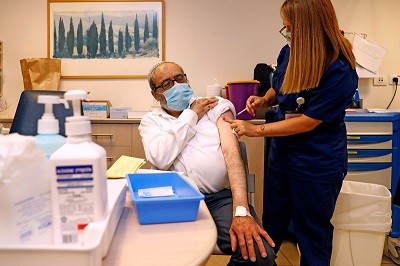Smriti Mallapaty reports in Nature:
People infected with the Delta variant of SARS-CoV-2 are more likely to spread the virus before developing symptoms than are people infected with earlier versions. On average, people began having symptoms 5.8 days after infection with Delta — 1.8 days after they first tested positive for viral RNA. That left almost two days for individuals to shed viral RNA before they showed any sign of COVID-19. As a result, 74% of infections with Delta took place during the presymptomatic phasePeople infected with the Delta variant of SARS-CoV-2 are more likely to spread the virus before developing symptoms than are people infected with earlier versions, suggests a detailed analysis of an outbreak in Guangdong, China1.
“It is just tougher to stop,” says Benjamin Cowling, an epidemiologist at the University of Hong Kong and a co-author of the study, which was posted on a preprint server on 13 August.
Cowling and his colleagues analysed exhaustive test data from 101 people in Guangdong who were infected with Delta between May and June this year, and data from those individuals’ close contacts. They found that, on average, people began having symptoms 5.8 days after infection with Delta — 1.8 days after they first tested positive for viral RNA. That left almost two days for individuals to shed viral RNA before they showed any sign of COVID-19.
A dangerous window
An earlier study2 and an unpublished analysis by Cowling and others estimate that before Delta emerged, individuals infected with SARS-CoV-2 took an average of 6.3 days to develop symptoms and 5.5 days to test positive for viral RNA, leaving a narrower window of 0.8 days for oblivious viral shedding.
In the latest work, the researchers also found that those infected with Delta had higher concentrations of viral particles, or viral load, in their bodies than did people infected with the original version of SARS-CoV-2. “Somehow the virus is appearing quicker and in higher amounts,” says Cowling.
As a result, 74% of infections with Delta took place during the presymptomatic phase — a higher proportion than for previous variants. This high rate “helps explain how this variant has been able to outpace both the wild-type virus and other variants to become the dominant strain worldwide”, says Barnaby Young, an infectious-disease clinician at the National Centre for Infectious Diseases in Singapore.
The researchers also calculated Delta’s ‘basic reproduction number’, or R0, which is the average number of people to whom every infected person will spread the virus in a susceptible population. They estimated that Delta has an R0 of 6.4, which is much higher than the R0 of 2–4 estimated for the original version of SARS-CoV-2, says Marm Kilpatrick, an infectious-disease researcher at the University of California, Santa Cruz. “Delta moves a bit faster, but is much more transmissible.”
A small number of study participants experienced ‘breakthrough infections’ with Delta after receiving two doses of an inactivated-virus COVID-19 vaccine. But the vaccine reduced participants’ viral loads at the peak of infection.
Vaccinated individuals were also 65% less likely than unvaccinated individuals to infect someone else, although the estimate was based on a very small sample size. This reduction “is significant and reassuring that COVID-19 vaccines remain effective and a vital part of our response to the pandemic”, says Young.
The study has not yet been peer reviewed.





















0 comments:
Post a Comment